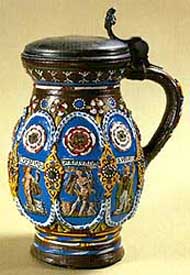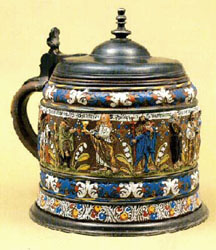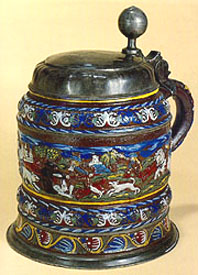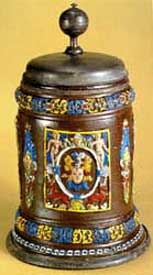
The town of Kreussen (also known as Creussen) is situated in the German province of Frankonia, just south of Bayreuth, not far from Nuremberg. Its recorded history goes back over 800 years and it is likely that it has always been associated with some form of pottery. The town’s name seems to have evolved from “Krause” or “Krausse” or “Kraussen,” middle-age words for a particular type of drinking vessel without a handle. In addition, a handled jug is part of Kreussen’s coat-of-arms. However, the major pottery period, the one we are interested in, spans the years of 1512 to 1760, a total of 248 years. The former year, 1512, is the date the first potter’s arrival is recorded — the Vest family arrived in Kreussen, founding what might almost be called a potter’s dynasty. The Vests had been potters in Vienna and hence brought their know-how with them. The final date, 1760, records the death of the last potter of that period, Johann Georg Schmidt. (See Table I). The “Golden Era” of Kreussen pottery can be taken as 1620-1700, a mere 80 years!
Kreussen was destroyed in 1633 during the 30-Years War but, paradoxically, it was this very war which, because of the migrations and relocations it caused, brought new artists, new methods and new techniques to the area. The city was again destroyed by fire in 1893 and once again it was rebuilt, but the glory of its past was only a memory, to be cherished and preserved by means of a potters’ museum and the continuing and worldwide fame of the ceramic vessels which had once been made there.
The ceramic industry of Kreussen can best be described by four defined periods:
1. Mid-l6th century — brown-ware (tin-glazed) with relief decorations, typical of the Italian renaissance; copies of early Faience ware. Faience workers almost certainly were not the same potters responsible for the work of the 2nd or 3rd period.2. Late 16th, early 17th century (ca. 1580-1610) — the “cold painting” period: smooth, flat ware decorated with unfired colors, most likely from the shop of Master Eyll (or Eull).
3. The polychrome period — started around 1620, but really developed only after 1633: vessels with salt-glazed brown background, painted with fired multi-colored glazes; relief figures (Apostle, Planet, Elector and Hunt steins). Rarer decorations: coats-of-arms, flowers, cherub faces, even the potter’s family.
4. The final period, lasting into the third quarter of the 18th century — plain, ordinary brown-ware, very little decoration, some relief work mostly utilitarian articles (jars, tiles water pipe).
As stein collectors, we are mostly interested in the 3rd period, during which the steins and tankards familiar to us were produced.
We can date the appearance of the categories of decoration motifs by the earliest known examples of each type:
a. Planet steins — 1610 (1620?)b. Apostle steins — 1627
c. Hunt steins — 1627
d. Elector steins — 1648
 |
After letting the fired vessels cool over a long period to prevent damage by chilling too rapidly, they were removed from the kiln and painted with tin-oxide-based colors. A second firing at lower temperatures (about 800°C) followed to set the colored glazes, i.e., melt them into the clay body. The stein, tankard or jug was now finished, except for the application of pewter fittings, a job reserved for “cottage industry” workers or itinerant pewterers. Some steins were sent to Nuremberg to have the pewter attached.
Kreussen clay, mined in the nearby Kapellberg, or Chapel Mountain, has its own inherent and typical color. Unfired it can vary from yellow to orange-brown, possibly due to its sulfur content. Fired but unglazed (as on the bottom or on the inside of steins) it has a gray to dirty-brown color. After being salt-glazed it has the familiar chocolate brown hue. It should be noted here that Kreussen salt-glazing (with “black salt”) results in a matte glaze — not the high gloss seen on imitations.
A note on color: There is a dispute regarding the first appearance of polychrome Kreussen-ware. Was it 1618 or 1622? Doubtlessly it was very close to this 5-year period. The colors used for polychroming were white, gray, black, brown, red, blue, yellow and green. Some gold was used, but this was a “cold,” i.e., unfired, color. That is why it is usually worn off on today’s Kreussen pieces.
The following Kreussen stoneware items and decorations are known:
A. Brown monochrome with incised decor;B. Brown monochrome with relief figures;
C. Brown base, polychrome;
1) Painted, no relief — Family steins, Apostle steins, Hunt steins
2) Painted, relief — Apostle steins, Planet steins, Elector steins, Hunt steinsD. Brown, with black and white decor: Mourning jugs;
E. Jugs, mugs, tankards pitchers, bottles, tiles;
F. Rarer less common decor: Coats-of-Arms, cherubs.
Let us briefly describe the four types of steins (or tankards) of prime interest to collectors:
Planet Steins — The earliest known example of these steins dedicated to the heavenly bodies is dated either as 1610 or 1620 (again a conflict). The usual order of the planets around the body of the stein (from the left, facing the stein) is: Saturn, Jupiter, Mars, Sol (Sun), Venus, Mercury, Luna (Moon). However, this order is not fixed and variations are not uncommon. The planets were given human figures and were represented either full-figure or as busts or just as heads.
Even the earliest Kreussen literature terms these vessels “Planetenkruge” hence calling these steins “astrologers’ steins” is definitely incorrect!
 |
Although all 12 Apostles (Disciples) may not appear on every stein, the order is always the same. No genuine Kreussen vessels have been found in which this order was changed! The Salvator figure is sometimes replaced by the well-known “Agnus Dei,” the Lamb of God, representing Jesus — Salvator.
Hunt Steins — The earliest known hunt stein is from 1627. These steins are considerably rarer than, say, Apostle steins. The backgrounds and hunt details are painted flat instead of applied relief. Only three types of hunt are illustrated — Bear, Fox and Rabbit. The steins often have a central applied medallion, usually showing a jumping stag. The more common and mix-labeled “hunt steins,” decorated with a relief stag hunt showing deer or stag, hunting dogs and hunter, with a central medallion featuring the bust of a man or woman, are certainly not of Kreussen origin. They were made in Saxony!
Elector Steins — The first known Elector (Kürfursten) stein is dated 1648. The order of the Electors is normally as follows, although some juxtapositional changes are known: Mainz, Trier, Cologne, Bohemia, Bavaria, Saxony, Brandenburg, Palatinate. Sometimes the Emperor, the man elected by the Electors, is shown centrally. History can give us a hint on whether the date of a stein confirms the shown Electors: Bavaria was included as an electorate state after 1623, at the expense of the Rhine-Palatinate, and in 1654 both became Elector territories again. After 1692, Hannover was added. Thus a 1650 dated stein showing the Palatinate (“Pfalz”) Elector could not have been produced prior to 1654. This “Elector” motif was very likely “adapted” from decorations on old glass vessels.
 |
The very best way to study the many types of decorations is to look at the catalogues of those museums which have good Kreussen holdings. These catalogues, such as references 6, 16 and 18, have good, clear illustrations and although the texts are in German the photographs alone make excellent study material.
No article on Kreussen steins can be considered complete without a note on the subject of imitations or reproductions. The most notable Kreussen reproductions, of course, are those produced in Saxony, specifically in the potters’ town of Annaberg, just southwest of Dresden. Dark-brown stoneware vessels, similar in superficial respects to Kreussen brown-ware, started to be manufactured there in the middle of the 17th century.
Some German ceramics authorities are currently, very cautiously, putting forth the theory that possibly Saxony stoneware dates to as early as the beginning of the 17th century and that perhaps it was the Kreussen potter who, in his own fashion, “copied“ the vessels from further north! In any case, these authorities feel Kreussen had no influence on Annaberg designs, regardless of their obvious similarity. However, the methods of manufacture and the decorations are often sufficiently unique to allow differentiation between Kreussen and Saxony stoneware. Kreussen vessels (specifically cylindrical or pear-shaped steins, tankards and jugs) were hand-thrown on the potters wheel and wall-sections are exceptionally thin, giving the vessel an unexpectedly light weight. The vessels were cut off the wheel with a wire, leaving characteristic marks, concentric circles, etc., on the base. Relief figures were looted on the body, since relief casting techniques were not used. Backgrounds were left plain or were given cross-cut designs. After firing and salt-glazing, the finish was a matte brown. Bottoms and insides of steins were left unglazed because, due to stacking the vessels in the furnaces, salt vapors could not get to these surfaces. Polychromed steins were decorated with tin-oxide based “melting” colors which were then fired and fixed to the clay substrate. Handles have oval cross-sections, and usually join the body near the middle of the cylinder.
 |
Pewter fittings are difficult to specifically identify, since often pewter work was given out to itinerants or to workers in other cities. Although at least 2 pewterers are known to have worked in Kreussen, they did not hallmark their work. Saxony pewterers both hallmarked and dated lids. (It must be remembered that it is relatively easy to “age” new pewter and to inscribe it with any desired date; furthermore it can be “distressed” to look very, very old. Hence the appearance or dating of pewter should be given only secondary credence in identifying stoneware items.)
Table II is a comparison of the more important feature differences between Kreussen and Saxony ware. Especially Saxony articles of the 18th century show “sloppy,” i.e., poor workmanship, somewhat akin to mass-production. We do not, however, want to give the impression that all one has to do to determine whether a tankard is a genuine “Kreussen” or a reproduction is to follow the cook-book approach of the table. There are many excellent imitations where the potter took special pains to copy the original in every detail, including using the authentic manufacturing methods. No simple a-b-c comparison will give the answer here. Indeed, in some instances chemical analysis of the clay would be the only way to determine whether it came from the Kapellberg in Kreussen or from a clay field in Saxony. Most museums today will identify items as “Kreussen-type,” rather than take a chance on later being proven wrong. Thus the average, even the well-informed, collector need not feel badly about his or her inability, even with much study, to tell the genuine article from the good reproduction. Collectors, however, should not be snobbish about 17th and 18th century Saxony steins and tankards. They are 200 to 300 years old, unique handiwork and, as stated earlier, not necessarily reproductions, but instead individual and artistic expressions. They are indeed, as price indicates, true antiques. In the late 19th century Villeroy & Bach imitated Kreussen steins with their nos. 2525 (1.6 liter pear-shaped tankard with medallion decoration), 2526 (½-liter stein with hunting scene) and 2527 (¼-liter stein with medallion portrait). V&B did not wish to deceive the buyer, but instead honored the Kreussen and Saxony potters by reproducing their designs. It is of interest that nos. 2526 and 2527 are the most expensive ½ and ¼-liter steins, respectively, in the 1899 catalogue!
Other known imitators were the firms of Fleischman Co. of Nuremberg (1868 ...), Salzer of Eisenach (1883), and J. Seller of Bayreuth (beginning 1900s). Especially the latter two made excellent, and difficult to spot, reproductions. Visitors to Bayreuth and Kreussen at the turn of the century expected to be able to purchase genuine souvenirs, and very large sums, running into many thousands of Marks even then, were paid for the “real thing.” In 1913, 22,000 Marks ($5500) was paid at auction for a genuine Kreussen tankard for the Emperor’s collection. Modern reproductions, not bad but easily identified as copies, are made by the firm of Christian Seyffahrth of Kreussen; they mark their copies with the incised initials “V.S.” Other modern copies, which would not even confuse the novice and of course, are not intended to, are produced by Rastal Werke of Höhr-Grenzhausen.
Polychrome decorations were no longer favored near the middle of the 18th century, and vessels were given to Bohemian Hausmaler (cottage industry painters and decorators) in the near-by Fichtel Mountains for decorating in the typical Bohemian fashion. The end of the “Golden Kreussen Period” came in 1760, when the last of the well-known master potters, Johann Georg Schmidt, distraught by competition from the near-by porcelain industry, felt his handiwork was no longer appreciated and committed suicide by drowning himself in a near-by lake, after also throwing all of his tools into the same lake. The passing of this last master may well be a piece of romanticized legend, but a later chronicler stated in Mainz in 1841, “Kreussen has outlived its era of brilliance .... Towards the end of the last century articles were made here which were equally famous all over Germany. They were the drinking tankards made by Master Schmidt, the potter. The Master, however, was very stubborn and took his art with him into his grave.”
Today [1977] prices for genuine Kreussen steins and tankards will range from $500 to $1500 for brown, monchrome pieces, and $1000 to $10,000 for polychrome pieces, depending on condition, decoration, pewter work, etc. Saxony pieces of the 17th and 18th century can bring almost similar prices: $750 to $5000 for good polychrome work. Later, 19th century Saxony pieces range from $250 up, depending on workmanship, condition, etc. Modern reproductions (post-1970) start at $100.
A final postscript: Why Kreussen? Why was it in this particular small town that such a unique artistry was practiced? How did the know-how originate, how did it suddenly develop, full-bloom, so to say, in such a brief period?
It is now believed that the “outside” world did indeed assert its influence upon Kreussen and that an influx of craftsmen at a critical time permitted an “instant” industry to spring up. As noted previously, Europe was in a turmoil due to the 30-Years War, 1618-1648. People were being dispersed, driven from their homesteads, forced to find new homes, often new livelihoods. The small Frankonian town, with its abundance of fine clay and possible safety due to location (the “safety” was to last only until 1633) seemed an ideal refuge for potters and artisans from elsewhere. Thus, from the Rhineland, from Frechen, from Raeren, from Siegburg came potters who had discovered the benefits of high-temperature stoneware firing and salt-glazing several centuries earlier. They brought with them furnace designs, methods of increasing kiln temperature and, importantly, decoration motifs and the technique of applying relief decorations by looting. They were already experts in the use of fired color glazes, although they had restricted themselves to cobalt blue and manganese purple in their homeland. From the east came Bohemian glass decorators who for years had turned plain glass into brilliant and distinctive articles. They had been the first to show a number of human figures, side-by-side, around the body of a drinking vessel, surrounded by flower garlands, often with the individual’s names above, below or to the side of the figure. They had immortalized political and religious leaders and they had used the glass vessel as “canvas” for their artistic strivings. Little wonder then that it took almost no time at all to translate the techniques from glass to stoneware, from flat painting to bas-relief polychroming.
Since most genuine, Kreussen articles are in museums today it is difficult for the average beer stein collector to examine these wondrous Kreussen drinking vessels first-hand. The collector must be satisfied with studying photographs in catalogues or in antique and hobby journals. Only very occasionally will he have the opportunity to actually see and touch an authenticated 17th to 18th century “Kreussen.” Hence for most of us the written word, the photograph and the reproduction must suffice.
There is no better way to close an article on Kreussen steins and tankards than to quote, in translation, one of the many verses or texts which graced these one-of-a-kind drinking vessels. In so doing we acknowledge the uniqueness, the craftsmanship and the beauty of these steins and pay the proper homage to artists long gone but remembered to this day by their works. In 1657, one of the master potters combined the holy with the profane to state:
God in your heart —
Your loved one in your arms;
The one makes you holy,
The other: Nice and warm.
**********
Bibliography —
These books, museum catalogs and magazine articles will give the beer stein collector a thorough background on the general subject of Kreussen (or Creussen) steins and their Saxony imitations. Unfortunately, many of the sources listed are in German; many are long out of print and unavailable in the United States. But the determined researcher should be able to locate enough to satisfy his hunger for knowledge! The letter (C) appearing directly behind the title refers to a museum catalog; the letter (G) at the end of the reference means that the listed publication is in German.
1. Ancient Art Stoneware of the Low Countries and Germany, M. O. Solon, Chiswick Press, London, 2 Vols., 1892.
2. “Apostle Steins,” Folly Fabel, Antiques Journal, May 1964, p. 14,
3. “Apostle Steins as Icons,” J. Joseph Hersh, Antiques Journal, August 1976, p. 53.
4. Book of Pottery and Porcelain, Warren E. Cox, Crown Publ., N.Y., 1968.
5. “Creussener Kruge”, anon., Hilton in Deutschland, Jan./Feb. 1974, p. 20. (G)
6. Creussener Steinzeug (C), Ekkart Klinge. Veste Coburg, Coburg, 1977. (G)
7. Creussener Topferkunst, Hans Eber, Bayerland Verlag, Munich, 1913. (G)
8. “German Stoneware”, Marion Thring, Antiques, November 1932, p. 186.
9. Geschichte der Stadt Creussen, Joachim Kroll, Verlag der Stadt Creussen, 1958. (G)
10. “Kreussen Steins”, Jack G. Lowenstein, Antiques Journal, Aug. 1971, p. 10.
11. Magister Johann Wills Geschichte von Creussen, Johann Wills (tr. by Theodor Drechsel), Lorenz Ellwanger Publ., Bayreuth, 1931. (G)
12. Pottery & Porcelain, Frederick Litchfield, M. Barrows & Co., NY, 1950.
13. Salt Glazed Stoneware, Edwin Atlee Barber, Pennsylvania Museum, Ceramic Series #6, 1906.
14. “Squat Steins are the Old Ones!” anon., Spinning Wheel, Nov. 1954, p. 20.
15. “Steins – The Jovial Drinking Vessels of Yesterday and Today”, Darwin H. Clark, Hobbies, Aug. 1972, p. 116. (Reprinted from the August 1953 issue of Hobbies.)
16. Steinzeug (C), Kunstgewerbemuseums Koln, Vol. 4, Cologne, 1971. (G)
17. “Steinzeug aus Creussen,” Walter Grasser, Suddeutsche Zeitung (Munich), May 2, 1977, p. 90. (G)
18. Steinzeug und Zinn (C), Annaliese Ohm and Margrit Bauer, Museum fur Kunsthandwerk, Frankfurt a/M, 1977. (G)
19. Stoneware & Porcelain, Daniel Rhodes, Chilton Book Co., Phila., 1968.
20. “Stoneware of Germany,” Geoffrey Wills, Discovering Antiques, issue 6, 1970, p. 130.
21. Topferkunst in Kreussen, Rudolph Albrecht, Rothenburg, 1913. (G)
22. “Creussener Steinzeug,” Gisela Reineking v. Bock, Keramos, issue no. 73, 1976, p. 7. (G)
23. “Steinzeug aus Creussen, Sachsen, Muskau und Bunzlau,” Konrad Strauss, Sammler Journal, Aug. 1977, p. 476. (G)
(See also Prosit nos. 22, Dec. 1970; 23, March 1971; 26, Dec. 1971; 42, Dec. 1975; and 43, March 1976 for articles by John A. Ey, Jr., J. Joseph Hersh and Jack G. Lowenstein on the subject of Kreussen and Kreussen-type steins.)
__________
*Reprinted by permission from Prosit, the Journal of Stein Collectors International, Issue No. 50, December 1977
Editors Note: The black and white pictures originally appearing with this article have been replaced with color photographs containing similar subject-matter.
New material ©1999 Beer Stein Library — All rights reserved.